
|
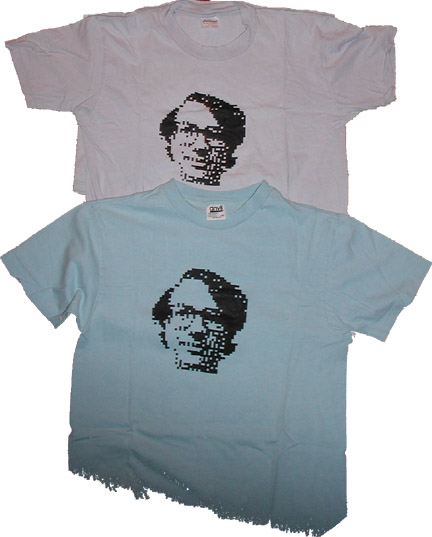
|

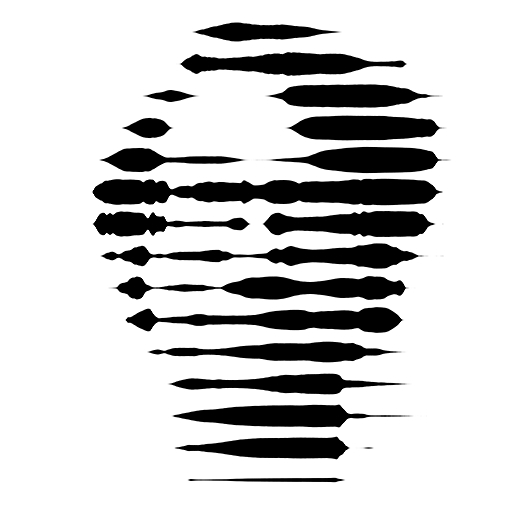 The fifth example from the digital darkroom
book (pages 42 and 43)
uses the portrait of Peter J. Weinberger, then a department head
in the Computer Science Research Center at Bell Labs (now at Google).
There is a long story behind the use of pjw's face for these
experiments, only some of which was told in the book.
Here is what the book said:
The fifth example from the digital darkroom
book (pages 42 and 43)
uses the portrait of Peter J. Weinberger, then a department head
in the Computer Science Research Center at Bell Labs (now at Google).
There is a long story behind the use of pjw's face for these
experiments, only some of which was told in the book.
Here is what the book said:
Within a few weeks after AT&T had revealed the new corporate logo, Tom Duff had made a Peter logo that has since become a symbol for our center. Rob Pike had T-shirts made. Ken Thompson ordered coffee mugs with the Peter logo. And, unavoidably, in the night of September 16, 1985, a Peter logo, 10 feet high, materialized on a watertower nearby.''

|

|
 Two different sets of T-shirts were made, shown above (thanks to Brian Redman,
Pat Parseghian,
and Jim McKie for unearthing the earlier shirts).
Rob's original version was plain white (above left), with just the PJW face.
Later Paul Glick had a second edition made in blue.
This version of the shirt had the slogan Where the avant-garde meets the rear guard on the back.
Another version of the shirt (above right), in both blue and white,
showed a digitized rendering of pjw's face.
Two different sets of T-shirts were made, shown above (thanks to Brian Redman,
Pat Parseghian,
and Jim McKie for unearthing the earlier shirts).
Rob's original version was plain white (above left), with just the PJW face.
Later Paul Glick had a second edition made in blue.
This version of the shirt had the slogan Where the avant-garde meets the rear guard on the back.
Another version of the shirt (above right), in both blue and white,
showed a digitized rendering of pjw's face.
Brian Redman recovered the original of the Bell Labs Cabinet chart and provided a scan of this important document (see image on the right). For the sentimental at heart, beyond the pictures, we can see a few cherished names on the chart from the old days at Bell Labs, such as John Tukey, Arno Penzias, and Vic Vyssotsky.
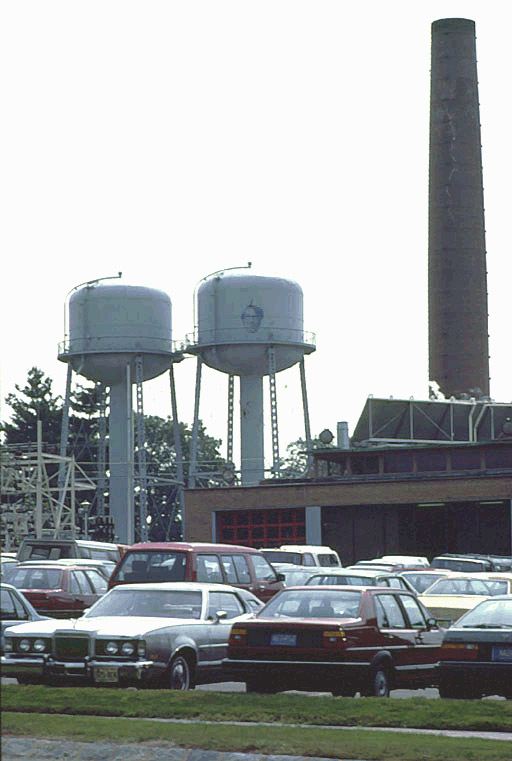 There is only one known picture of the watertower with the logo.
It is shown to the right.
There was not much time to record the event: the image was painted
over by plant management within one day after it appeared.
Meanwhile, these two watertowers have also disappeared.
Many years ago they were replaced with a single, much larger,
structure that could in principle also accomodate a much larger
version of the logo.
There is only one known picture of the watertower with the logo.
It is shown to the right.
There was not much time to record the event: the image was painted
over by plant management within one day after it appeared.
Meanwhile, these two watertowers have also disappeared.
Many years ago they were replaced with a single, much larger,
structure that could in principle also accomodate a much larger
version of the logo.
We do not know for certain who painted the picture on the watertower. Mechanically, it was done with a large template and spray paint. We do know that the paint itself was vouchered a few days later as a business expense by Fred Grampp, on behalf of a pseudo-employee G.R. (Grace) Emlin (login: gremlin), who had at that time already been entered successfully into most official databases at Bell Labs, and regularly received mail at her mailbox at 2C-501 (the Unix room).
 There were many more uses of Peter's image than can be
recorded here. We managed to get a transformation of the image on the
cover of the AT&T Technical Journal in March 1987 (left).
But we also made sure it appeared in lots of other,
less conspicuous places.
It appears, for instance, within the layout diagrams of some
of the chips that our center produced at that time, and it appeared
as a hidden tiny image somewhere on every CD cover image that
we produced.
There were many more uses of Peter's image than can be
recorded here. We managed to get a transformation of the image on the
cover of the AT&T Technical Journal in March 1987 (left).
But we also made sure it appeared in lots of other,
less conspicuous places.
It appears, for instance, within the layout diagrams of some
of the chips that our center produced at that time, and it appeared
as a hidden tiny image somewhere on every CD cover image that
we produced.
 For instance, in the CD cover image on the right, PJW's face is
visible in the dark area of the wrist.
In the original Plan9 distribution CD, shown below, the PJW face is
held by one of the characters from the movie (see arrows).
For instance, in the CD cover image on the right, PJW's face is
visible in the dark area of the wrist.
In the original Plan9 distribution CD, shown below, the PJW face is
held by one of the characters from the movie (see arrows).
Insiders also know that hidden images of PJW can be
found embedded in the cement under the machinery that was being
installed around that time in our buildings.
 The picture on the left was taken a few days before something
big and heavy was installed on the spot with the newly poured
cement. Later, this slab of cement was hiding underneath
new offices from the Bell Labs PR department. No doubt, the
occupants of these offices didn't have a clue about it.
Norman Wilson has confessed to making the imprint in the cement,
using a stencil cut-out of the PJW logo.
The picture on the left was taken a few days before something
big and heavy was installed on the spot with the newly poured
cement. Later, this slab of cement was hiding underneath
new offices from the Bell Labs PR department. No doubt, the
occupants of these offices didn't have a clue about it.
Norman Wilson has confessed to making the imprint in the cement,
using a stencil cut-out of the PJW logo.
Below is a list, in no particular order, of some the other uses of PJW's face over the years:
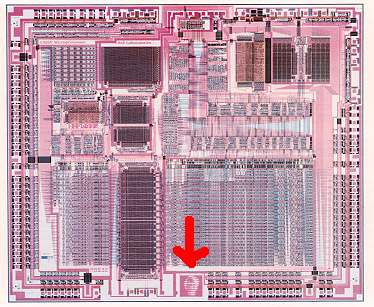
|
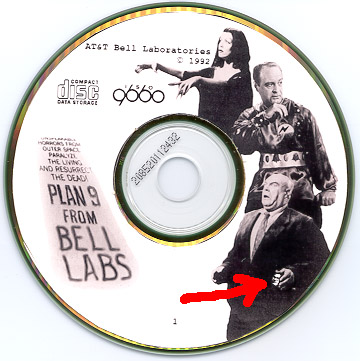
|

|
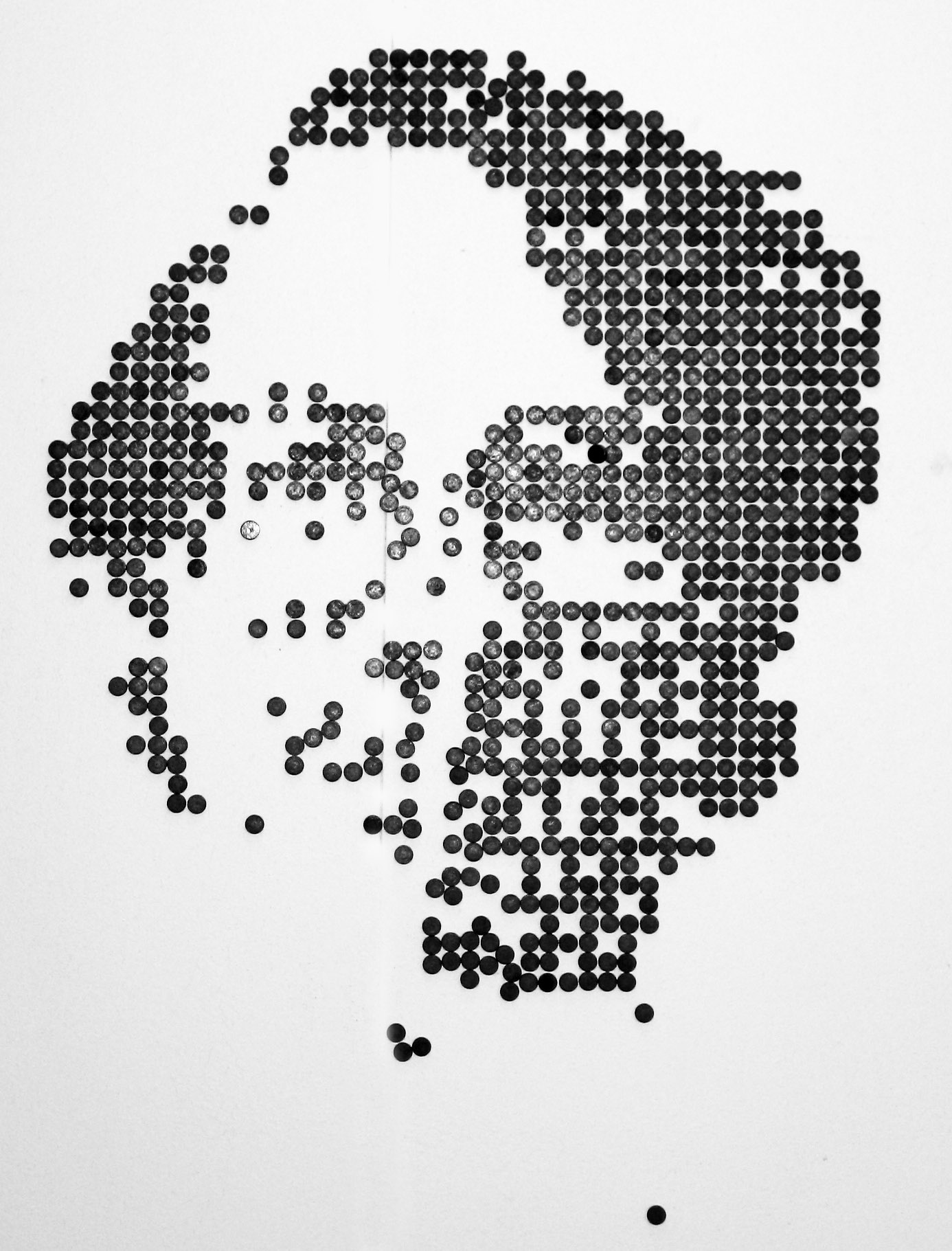 PJW's face was spliced into a disabled logo outside the mens room
on Stair 8 (the same stair where a large PJW face still appears on
the wall in the form of magnets. The state of the magnet arrangement
in March 2009 is shown to the right, in a photo taken by Peter Patel-Schneider,
see also below for more on this).
PJW's face was spliced into a disabled logo outside the mens room
on Stair 8 (the same stair where a large PJW face still appears on
the wall in the form of magnets. The state of the magnet arrangement
in March 2009 is shown to the right, in a photo taken by Peter Patel-Schneider,
see also below for more on this).
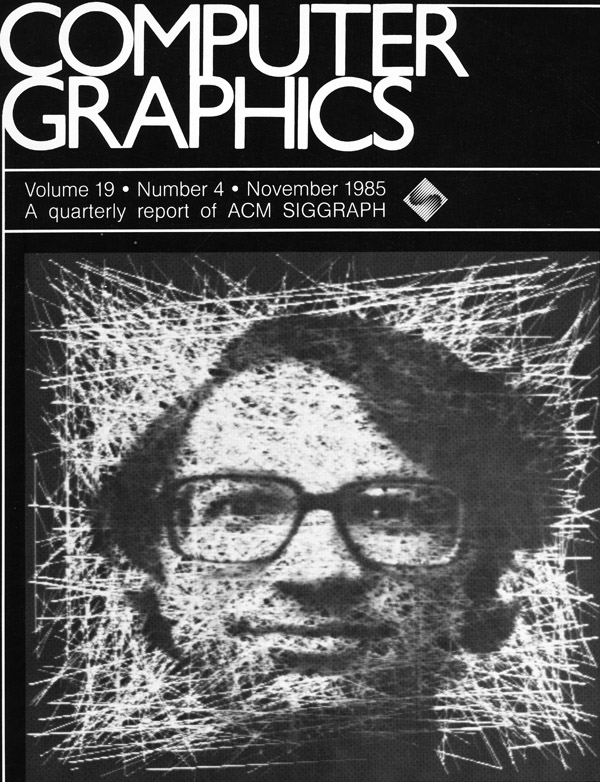 A transformation of Peter's image also appeared on the cover
of the magazine Computer Graphics in November 1985, Vol. 19, Nr. 4.
The scan on the right is courtesy of Renee French.
A transformation of Peter's image also appeared on the cover
of the magazine Computer Graphics in November 1985, Vol. 19, Nr. 4.
The scan on the right is courtesy of Renee French.
 PJW's face appears painted on the wall in at least
one of the fifth floor offices in the Murray Hill building, 2C-517
(see the back wall in the image on the right).
The office used to belong to Ed Sitar, our system administrator
at the time, now retired. (Ed also appears in the 9th picture in
the book, on pages 50 and 51.)
PJW's face appears painted on the wall in at least
one of the fifth floor offices in the Murray Hill building, 2C-517
(see the back wall in the image on the right).
The office used to belong to Ed Sitar, our system administrator
at the time, now retired. (Ed also appears in the 9th picture in
the book, on pages 50 and 51.)
 Many hundreds of prints of PJW's face were distributed as masks
(with eyes and mouths cut out) at a large lab-wide meeting in the
Murray Hill Auditorium, when Peter's promition to VP was announced.
Unbeknownst to Peter, the masks were distributed at the entrance
to the auditorium, at the start of the meeting, and on cue,
when Peter took the microphone, everyone in the audience donned his
or her mask, to great effect.
Many hundreds of prints of PJW's face were distributed as masks
(with eyes and mouths cut out) at a large lab-wide meeting in the
Murray Hill Auditorium, when Peter's promition to VP was announced.
Unbeknownst to Peter, the masks were distributed at the entrance
to the auditorium, at the start of the meeting, and on cue,
when Peter took the microphone, everyone in the audience donned his
or her mask, to great effect.
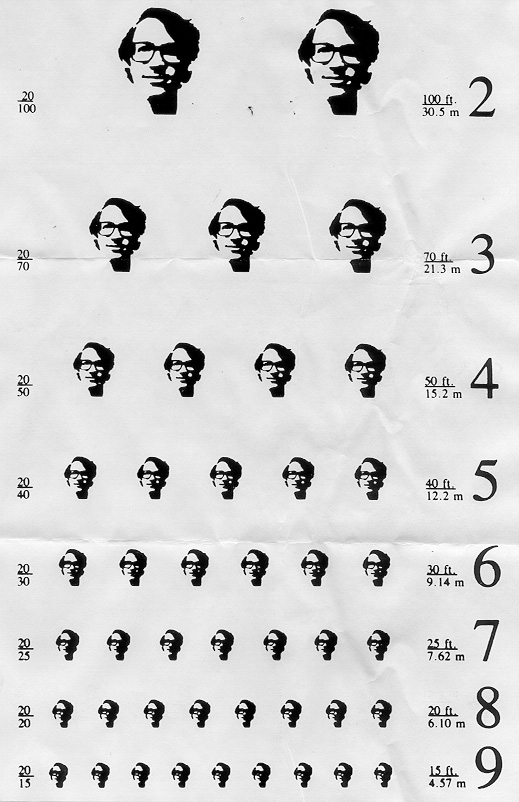 A special PJW symbol was added to the symbols font of our troff
typesetting system. This led to the creation of a special PJW
eyechart, with the PJW face rendered in a variety of sizes.
(Picture courtesy of Bob Flandrena.)
A special PJW symbol was added to the symbols font of our troff
typesetting system. This led to the creation of a special PJW
eyechart, with the PJW face rendered in a variety of sizes.
(Picture courtesy of Bob Flandrena.)
 When we decided to try and branch out from 2-d imaging into 3-d
surface rendering, Peter agreed to let us take a plaster cast of
his faces. Lillian Schwartz (picture 19 in the book, pages 70 and 71)
agreed to help make the mask, which happened in Lillian's studio.
A polaroid picture I took of the event is on the right.
Our initial plan had been to use a 3-d cast of PJW's face to replace
the bust of Alexander Graham Bell, in the Murray Hill lobby on April 1st.
Luckily, we did not attempt this feat; it probably would not have been
appreciated much.
When we decided to try and branch out from 2-d imaging into 3-d
surface rendering, Peter agreed to let us take a plaster cast of
his faces. Lillian Schwartz (picture 19 in the book, pages 70 and 71)
agreed to help make the mask, which happened in Lillian's studio.
A polaroid picture I took of the event is on the right.
Our initial plan had been to use a 3-d cast of PJW's face to replace
the bust of Alexander Graham Bell, in the Murray Hill lobby on April 1st.
Luckily, we did not attempt this feat; it probably would not have been
appreciated much.
 Similarly, when Rob Pike left in October 2002 to join Google, we
used PJW's image for a cake. Margaret Smith is putting the finishing
touches to the cake in the picture on the right.
Similarly, when Rob Pike left in October 2002 to join Google, we
used PJW's image for a cake. Margaret Smith is putting the finishing
touches to the cake in the picture on the right.